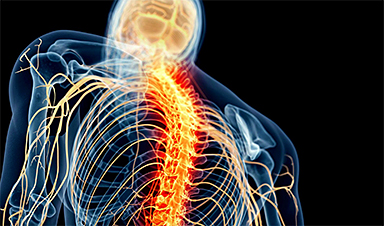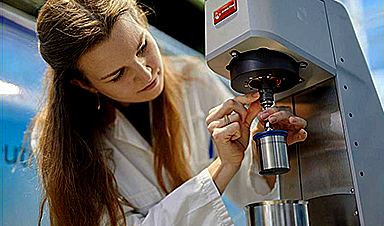A new study published in the Journal of Neuroscience indicates that the sense of smell is significantly influenced by cues from other senses, whereas the senses of sight and hearing are much less affected.
A popular theory of the brain holds that its main function is to predict what will happen next, so it reacts mostly to unexpected events. Most research on this topic, called predictive coding, has only focused on what we see, but no one knows if the different senses, such as smell, work in the same way.
To figure out more about how smell relates to how we handle different sensory impressions, the researchers conducted a study with three experiments, two behavioral experiments, and one experiment using the brain imaging method fMRI at Stockholm University Brain Imaging Centre (SUBIC).
“The main finding is that smelling was much more dependent on predictions than vision was. This is interesting because many people think that smell is primitive and reactive, when our research shows it is in fact quite sophisticated and proactive,” says Stephen Pierzchajlo, PhD Student at the Department of Psychology, and main author of the study.
The study shows how important it is for our different senses to be able to use correct cues when we classify different sensory impressions.
Sensory Interactions and Predictions
“We have all experienced that we react to when an unexpected smell appears, for example when we enter someone’s flat and encounter a new smell. Our research shows that the sense of smell is highly influenced by the cues from other senses, while the sense of sight and hearing are affected to a much lesser extent,” says Jonas Olofsson, professor at the Department of Psychology, and co-author of the study.
The researchers also show that when the brain tries to identify odors that it had not expected, both the olfactory and visual brains are activated, despite the absence of visual cues in the task.
“The olfactory brain thus has a completely unique way of processing smells and it is about whether the smells are expected or not. The sense of smell warns us of smells that we had not expected, and engages the visual brain, perhaps to be able to see what it is that smells. It’s a smart function because we humans are so bad at recognizing smells if we don’t get clues,” says Jonas Olofsson.
In the experiments, participants listened to spoken word cues, such as “lemon”, and then received a picture or smell, and participants quickly decided whether it matched with the cue, for example with a lemon picture or smell, or did not match, for example with a rose picture or smell.
“We noticed that overall, the expected pictures and smells led to quicker decisions, which fits well with predictive coding theory. We used the difference in response speed to compare the senses with each other – a bigger delay for unexpected stimuli means that the sense relies more on predictions,” says Stephen Pierzchajlo.
The study is the first concluded part of his PhD research.
“The human sense of smell is not a reactive, but a proactive sense. It uses a unique brain strategy to process unexpected smells in order to understand what the smells are,” says Stephen Pierzchajlo.
Reference: “Olfactory categorization is shaped by a transmodal cortical network for evaluating perceptual predictions” by Stephen Pierzchajlo, Teodor Jernsäther, Lara Fontana, Rita Almeida and Jonas K. Olofsson, 31 March 2024, Journal of Neuroscience.
DOI: 10.1523/JNEUROSCI.1232-23.2024
The study was funded by the Knut och Alice Wallenbergs Stiftelse, Swedish Research Council, Stockholm University.
News
The Silent Battle Within: How Your Organs Choose Between Mom and Dad’s Genes
Research reveals that selective expression of maternal or paternal X chromosomes varies by organ, driven by cellular competition. A new study published today (July 26) in Nature Genetics by the Lymphoid Development Group at the MRC [...]
Study identifies genes increasing risk of severe COVID-19
Whether or not a person becomes seriously ill with COVID-19 depends, among other things, on genetic factors. With this in mind, researchers from the University Hospital Bonn (UKB) and the University of Bonn, in [...]
Small regions of the brain can take micro-naps while the rest of the brain is awake and vice versa
Sleep and wake: They're totally distinct states of being that define the boundaries of our daily lives. For years, scientists have measured the difference between these instinctual brain processes by observing brain waves, with [...]
Redefining Consciousness: Small Regions of the Brain Can Take Micro-Naps While the Rest of the Brain Is Awake
The study broadly reveals how fast brain waves, previously overlooked, establish fundamental patterns of sleep and wakefulness. Scientists have developed a new method to analyze sleep and wake states by detecting ultra-fast neuronal activity [...]
AI Reveals Health Secrets Through Facial Temperature Mapping
Researchers have found that different facial temperatures correlate with chronic illnesses like diabetes and high blood pressure, and these can be detected using AI with thermal cameras. They highlight the potential of this technology [...]
Breakthrough in aging research: Blocking IL-11 extends lifespan and improves health in mice
In a recent study published in the journal Nature, a team of researchers used murine models and various pharmacological and genetic approaches to examine whether pro-inflammatory signaling involving interleukin (IL)-11, which activates signaling molecules such [...]
Promise for a universal influenza vaccine: Scientists validate theory using 1918 flu virus
New research led by Oregon Health & Science University reveals a promising approach to developing a universal influenza vaccine—a so-called "one and done" vaccine that confers lifetime immunity against an evolving virus. The study, [...]
New Projects Aim To Pioneer the Future of Neuroscience
One study will investigate the alterations in brain activity at the cellular level caused by psilocybin, the psychoactive substance found in “magic mushrooms.” How do neurons respond to the effects of magic mushrooms? What [...]
Decoding the Decline: Scientific Insights Into Long COVID’s Retreat
Research indicates a significant reduction in long COVID risk, largely due to vaccination and the virus’s evolution. The study analyzes data from over 441,000 veterans, showing lower rates of long COVID among vaccinated individuals compared [...]
Silicon Transformed: A Breakthrough in Laser Nanofabrication
A new method enables precise nanofabrication inside silicon using spatial light modulation and laser pulses, creating advanced nanostructures for potential use in electronics and photonics. Silicon, the cornerstone of modern electronics, photovoltaics, and photonics, [...]
Caught in the actinium: New research could help design better cancer treatments
The element actinium was first discovered at the turn of the 20th century, but even now, nearly 125 years later, researchers still don't have a good grasp on the metal's chemistry. That's because actinium [...]
Innovative Light-Controlled Drugs Could Revolutionize Neuropathic Pain Treatment
A team of researchers from the Institute for Bioengineering of Catalonia (IBEC) has developed light-activated derivatives of the anti-epileptic drug carbamazepine to treat neuropathic pain. Light can be harnessed to target drugs to specific [...]
Green Gold: Turning E-Waste Into a Treasure Trove of Rare Earth Metals
Scientists are developing a process inspired by nature that efficiently recovers europium from old fluorescent lamps. The approach could lead to the long-awaited recycling of rare earth metals. A small molecule that naturally serves [...]
Cambridge Study: AI Chatbots Have an “Empathy Gap,” and It Could Be Dangerous
A new study suggests a framework for “Child Safe AI” in response to recent incidents showing that many children perceive chatbots as quasi-human and reliable. A study has indicated that AI chatbots often exhibit [...]
Nanoparticle-based delivery system could offer treatment for diabetics with rare insulin allergy
Up to 3% of people with diabetes have an allergic reaction to insulin. A team at Forschungszentrum Jülich has now studied a method that could be used to deliver the active substance into the [...]
Nanorobot kills cancer cells in mice with hidden weapon
Researchers at Karolinska Institutet in Sweden have developed nanorobots that kill cancer cells in mice. The robot's weapon is hidden in a nanostructure and is exposed only in the tumor microenvironment, sparing healthy cells. [...]




















